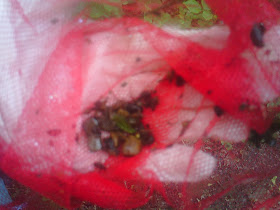 Running through the lower edge of Ravenscliffe Wood is Fagley Beck (beck is a commonly used word for a stream in Northern England)As we enter the woods, the children often comment on how high or low the water is running and where the water comes from and flows to. Looking at maps of the area, we have found that the beck flows out of Ravenscliffe Wood towards West Wood where it then becomes known as Carr Beck after which point, the beck disappears underground. The nearest river is the River Aire, so the children said they believe that the water perhaps makes its way there underground.
Running through the lower edge of Ravenscliffe Wood is Fagley Beck (beck is a commonly used word for a stream in Northern England)As we enter the woods, the children often comment on how high or low the water is running and where the water comes from and flows to. Looking at maps of the area, we have found that the beck flows out of Ravenscliffe Wood towards West Wood where it then becomes known as Carr Beck after which point, the beck disappears underground. The nearest river is the River Aire, so the children said they believe that the water perhaps makes its way there underground. We have often wondered what may live in the water, so today Birch group armed with nets, decided to investigate. Before heading down to the beck, we discussed how to be safe around water. At its deepest point, the beck is knee high, but even relatively shallow water can pose risks. There is also the added concern that the locality is subject to fly tipping which can lead to rubbish making its way into the water. As the woodland is home to a range of wildlife we thought about animals which may drink from the water and that they may also leave animal waste in the water. The children agree to the following rules to keep us safe:
We have often wondered what may live in the water, so today Birch group armed with nets, decided to investigate. Before heading down to the beck, we discussed how to be safe around water. At its deepest point, the beck is knee high, but even relatively shallow water can pose risks. There is also the added concern that the locality is subject to fly tipping which can lead to rubbish making its way into the water. As the woodland is home to a range of wildlife we thought about animals which may drink from the water and that they may also leave animal waste in the water. The children agree to the following rules to keep us safe: 1) Cover any cuts or grazes with waterproof tape (to prevent the risk of infection from waterborne disease - see the ROSPA website for more information).
1) Cover any cuts or grazes with waterproof tape (to prevent the risk of infection from waterborne disease - see the ROSPA website for more information).2) Only enter water where we can see to the bottom (in case there are sharp or dangerous objects under the water.
3) Test the depth of the water and the firmness of the riverbed with the end of our nets before stepping in it.
4) Only enter water below welly boot height.
5) Always stay where another member of the group can see you.
 We made our way along the riverbank keeping our eyes peeled for signs of life in the water. Akasha spotted some small creatures moving around and managed to fish them out. We believe they may be some form of freshwater shrimp. For more information on freshwater habitats, visit the Freshwater Habitats Trust website. As we continued to walk, Aroona recognised wild garlic growing with its unmistakably pungent aroma. We were also able to see tracks in the soft mud of animals that had visited the water.
We made our way along the riverbank keeping our eyes peeled for signs of life in the water. Akasha spotted some small creatures moving around and managed to fish them out. We believe they may be some form of freshwater shrimp. For more information on freshwater habitats, visit the Freshwater Habitats Trust website. As we continued to walk, Aroona recognised wild garlic growing with its unmistakably pungent aroma. We were also able to see tracks in the soft mud of animals that had visited the water. On this occasion, we did not find any fish in the water so we considered why this may be. Perhaps the water wasn't deep enough for them to survive, perhaps they were hiding from us or maybe the water quality wasn't good enough. Birch group are due to visit Yorkshire Water in a few weeks time with their class, so maybe they will be able to find out more about water quality and water habitats during their visit.
On this occasion, we did not find any fish in the water so we considered why this may be. Perhaps the water wasn't deep enough for them to survive, perhaps they were hiding from us or maybe the water quality wasn't good enough. Birch group are due to visit Yorkshire Water in a few weeks time with their class, so maybe they will be able to find out more about water quality and water habitats during their visit.
No comments:
Post a Comment